What’s Up?
The summer doldrums continue but I manage to rustle up a good chance or two every morning. I spent most of Friday morning with a young Great Egret preening on The Perch II. I kept only a very few. Saturday morning was next to nothing. I kept only a few Limpkin images.
I’ve been using the 400-800 more and more every day. It pairs perfectly with either the 600mm f/4 GM and the 2X or with the 300mm f/2.8 GM bare or with either TC. The more I use it, the more I love it. If you decide to purchase one, be sure to use one of my two affiliate links to earn a free copy of the BAA Sony 400-800mm Lens Guide. Confused? See the info on the guide below.
On Saturday, I seriously began getting some stuff in a suitcase and getting my photo gear cleaned and organized my trip to Long Island. I take the Auto Train north to Lorton, VA on Monday afternoon.
Today is Sunday 3 August 2025 and I will of course be heading down to the lake early in search a miracle or two. Whatever you opt to do, I hope that you too choose to have a wonderful and productive day and that you have fun too. Do remember that happiness is a choice — Byron Katie, The Work.Com.
If you’ve been thinking of joining me for one of the two Nickerson Beach IPTs, please e-mail for late registration discount info. See here and scroll down for details.
If an item — a Delkin flash card or reader, a Levered-clamp FlexShooter Pro, or a Wimberley lens plate or low foot — for example, that is available from B&H and/or Bedfords, is also available in the BAA Online Store, it would be great, and greatly appreciated, if you would opt to purchase from us. We will match or beat any price. Please remember also to use my B&H affiliate links or to earn 3% cash back at Bedford by using the BIRDSASART discount code at checkout for your major gear purchases. Doing either often earns you free guides and/or discounts. And always earns my great appreciation.
Gear Questions and Advice
Too many folks attending BAA IPTs and dozens of photographers whom I see in the field and on BirdPhotographer’s.Net, are — out of ignorance — using the wrong gear, especially when it comes to tripods and more especially, tripod heads. And the same is true in spades when ordering new camera bodies or lenses. My advice will often save you some serious money and may help you avoid making a seriously bad choice. Please know that I am always glad to answer your gear questions via e-mail. If you are desperate, you can try me on my cell at 863-221-2372. Please leave a message and shoot me a text if I do not pick up.
Don’t Just Shoot: Learn
If you are interested in changing your life and becoming a better photographer by joining me on the Extended IPT at Sebastian Inlet for Ospreys and more (SEPT 25 to NOV 24, 2025), in San Diego for Pacific-race Brown Pelicans and more (JAN 6 to FEB 2, 2026), or for Roseate Spoonbills at Stick Marsh (March 2026), please e-mail for dates, rates, terms, and additional information. Or shoot me a text to 863-221-2372. Some offerings include options for shared AirBnB lodging and meals. Ground transportation during your stay is a possibility at times.
B&H Simplified
To ensure that I get credit for your B&H purchases, you can always click here. The tracking is invisible but using my affiliate links is greatly appreciated. And, with B&H, you can use your PayBoo card. You must use the website to order. You cannot get your free guides if you make a phone order. Once you have an item in your cart, you must complete the order within two hours. Huge thanks!
B&H
Many folks have written recently stating that they purchased a Sony a1 from B&H and would like their free membership in the Sony 1 Info and Updates Group, a $150.00 value. But when I check my affiliate account, their orders have not been there. When I let them know that they get credit for B&H purchases only if they use one of the many B&H affiliate links on the blog or begin their searches with this link, they are always disappointed. If in doubt, please contact me via e-mail and request a BH link. I am always glad to help and to guide you to the right gear.
Bedfords Simplified
Click here to start your search. Choose standard shipping, and when you get to the payment page, enter BIRDSASART in the discount code box and hit apply. You will be upgraded to free second day air Fed-Ex and receive 3% cash back on your credit card once your stuff ships. Using either my affiliate links is greatly appreciated and will often earn you free guides or discounts.
Bedfords Amazing BAA Discount Policy
Folks who have fallen in love with Bedfords can always use the BIRDSASART coupon code at checkout to enjoy a post-purchase, 3% off-statement credit (excluding taxes and shipping charges) on orders paid with a credit card. The 3% credit will be refunded to the card you used for your purchase when your product ships. Be sure, also, to check the box for free shipping to enjoy free Second Day Air Fed-Ex. This offer does not apply to purchases of Classes, Gift Cards, or prior purchases.
You can visit the Bedfords website here, shoot Steve Elkins an e-mail, or text him on his cell phone at (479) 381-2592.
|
|
|
This image was created on 27 July 2025 as I walked the pier at the lake near my home at Indian Lake Estates, FL. I used the handheld Sony FE 400-800mm f/6.3-8 G OSS lens (Sony E) (at 633mm) and the SONY a-1, (now replaced by The Latest Greatest Sony Flagship Body, the a1 II Mirrorless Camera). The exposure was determined by Zebras with ISO on the rear wheel: ISO 1600: 1/1600 sec. at f/9 (stopped down 1/3-stop) in Manual mode. RawDigger showed that the exposure was dead solid perfect. AWB at 7:36:52am on a sunny, hazy morning. Wide/AF-C with Bird-Eye/Face Detection performed perfectly. Click on the image to enjoy the larger, inexplicably sharper high-res version. Image #1: Tricolored Heron adult subduing a Prince Baskettail (Epitheca princeps). |
Recovered!
When I accidentally formatted a card with eight days of images (some miraculous) while helping Pat Fishburne with her a9 iii menu, I was confident that I would be able to recover them. You are, however, always a bit edgy until you see them on your computer. Had I lost the images, the tricolored/dragonfly series was the one I would have missed the most. I kept 14 of about 350 of the photos that I created during the fifteen seconds that the bird was square to me. Depth of field and dragonfly position and pose issues were the main factors that separated the wheat from the chaff.
After jumping off the railing and grabbing the baskettail in midair, the bird posed perfectly (as above) and then turned away from me as it attempted to swallow its prey. It struggled for a minute until only the tip of one forewing was sticking out of a corner of its mouth. But, it could not get the insect down completely. Next, it choked it back up, and promptly dropped it into the lake! A lot of work with no gain.
Thanks Blair
I first met Blair Nikula probably 40 years or so ago on Cape Cod. He was doing shorebird surveys at Monomoy for the then Manomet Bird Observatory. I was doing the count at Jamaica Bay Wildlife Refuge in the mid-1980s. We were both friends with the renowned Red Knot expert Brian Harrington. Anyhoo, he took me out to Monomoy for a day of shorebirding and photography. Blair liked to go fast and I can still remember that kidney-pounding ride!
Over the years, Blair became a dragonfly expert. He kindly responded to my e-mail query as to the species in the bill of the tricolored:
Good to hear from you – I’m still an avid follower of your blog! All is well here in MA, except it’s too damn hot!
The dragonfly is a Prince Baskettail (Epitheca princeps). They generally fly at treetop level, well out of the reach of most predators (other than kites), but that’s a female (a “Princess” baskettail ;)) who apparently was about to lay eggs. You can see some the yellowish egg cluster at the tip of her abdomen in the second shot. Unlike most dragonflies that lay their eggs a few at a time, baskettails carry all of their eggs in one large cluster (or “basket”) at the tip of their abdomen (thus the name “baskettails”), before dropping them into the water all at once. This lady obviously got nailed before she completed her mission. But maybe some of those eggs dropped into the water and will survive – if they’re not eaten by fish, or frogs, other dragonfly nymphs, birds, or any of a myriad of other potential predators.
After I sent him a few more dragonfly images to identify, he suggested that I get a copy of Dragonflies of North America (Princeton Field Guides). He wrote, It is a superb field guide by Ed Lam (a fellow New Yorker) and was published late last year. It is quite simply one of the finest field guides to any group of organisms I’ve ever seen, and at only about $20 it is one of the all-time great book bargains.
|
|
|
This image was also and obviously created on 27 July 2025 as I walked the pier at the lake near my home at Indian Lake Estates, FL. I used the handheld Sony FE 400-800mm f/6.3-8 G OSS lens (Sony E) (at 685mm) and the SONY a-1, (now replaced by The Latest Greatest Sony Flagship Body, the a1 II Mirrorless Camera). The exposure was determined by Zebras with ISO on the rear wheel: ISO 1600: 1/1600 sec. at f/9 (stopped down 1/3-stop) in Manual mode. RawDigger showed that the exposure was dead solid perfect. AWB at 7:37:06am on a sunny, hazy morning. Wide/AF-C with Bird-Eye/Face Detection performed perfectly. Click on the image to enjoy the larger, inexplicably sharper high-res version. Image #2: Tricolored Heron adult subduing a Prince Baskettail (Epitheca princeps). |
Fourteen Seconds Later
Notice that the exposure was never changed during the bursts but that for this image, I did zoom in a bit (to 685mm).
Your Call?
Which image do you like better, #1 or #2? Why? Which background do you like better?
Image Rescue Programs
Several folks ask what programs I use for image recovery; I have two favorites:
PHOTORECOVERY® Standard from LC Tehnology
EaseUS Data Recovery Wizard Pro
Both work exceedingly well. I have previously tried other programs but found them too complicated. Both of the programs above are straightforward.
|
|
Image #2A: An unsharpened 100% crop of the “Tricolored Heron adult subduing a Prince Baskettail (Epitheca princeps)” image. |
Sony 400-800 Sharpness
Folks often ask me, Is the 400-800 G lens as sharp as the 600mm f/4 GM lens? As I work only on my MacBook Pro, I cannot see any differences at all. As you can see above, the 400-800 is capable of creating superbly sharp incredibly detailed images.
In this tight crop, you get a good look at the dragonfly’s yellowish string of eggs.
The BIRDS AS ART SONY 400-800mm f/6.3-9 G Super-telephoto Zoom Lens Guide
When I borrowed this lens from Sony, I assumed that at 5.45 pounds it was too heavy to handhold for long and that at f/8 at the long end (800mm,) it was too slow for most bird photography applications. In short, I did not want to like the lens. After a month of using it, I cannot live without it. After returning the loaner, I was miraculously able to get my own from Bedfords on 16 April 2025. In this guide I share everything that I have learned about using the 400-800. For best results, you need to know exactly what you are doing to get the most out of this zoom lens. It would be best, therefore, to consider and study the material in the guide so that you can begin making great images with your new lens.
You will learn how to deal with the relatively show apertures: f/6.3, f/7.1, and f/8 when working in Manual mode.
You will learn how to ensure that you are working at the widest aperture by working in Shutter Priority mode with AUTO ISO.
If you are able to hand hold the lens, you will learn proper hand holding techniques.
If you can’t, you will learn when, why, and how to employ other options. Those include:
1- The knee-pod, heel-pod, and toe-pod techniques
2- Using the lens on a monopod.
3- The best lens plate and low foot for your 4-8.
4- The best tripod and head for the 4-8 and how best to utilize them.
5- How to use the lens from your vehicle while supporting it on a BLUBB (or not and why not).
6- Detailed instructions on how to set and use the lens controls and buttons:
a- AF/MF
b- DMF Switch
c- Limit Range Switch
d- OSS (Optical Steady Shot) Switch
e- OSS Mode Switch
f- Focus Hold Buttons
The guide also includes a Hand Holding Shutter Speed Primer and an illustrative, educational, and inspiring 67-image gallery.
Free to folks who use one of my two affiliate links to purchase their Sony 400-800 G lens. Otherwise, please send a PayPal for $115.43 to birdsasart@verizon.net and include the words “400-800 Lens Guide” in your e-mail.


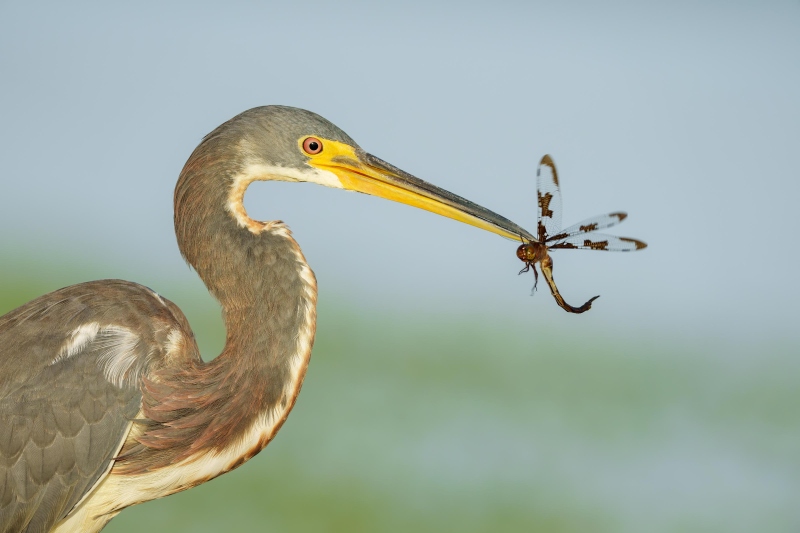
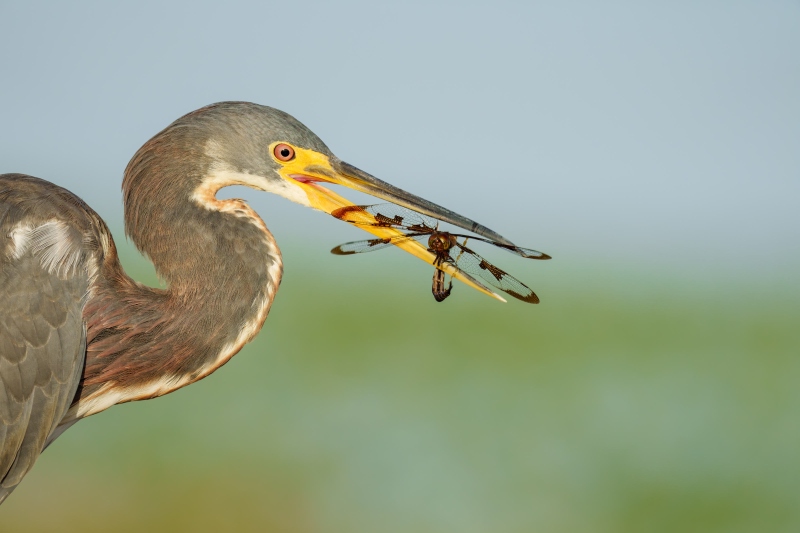
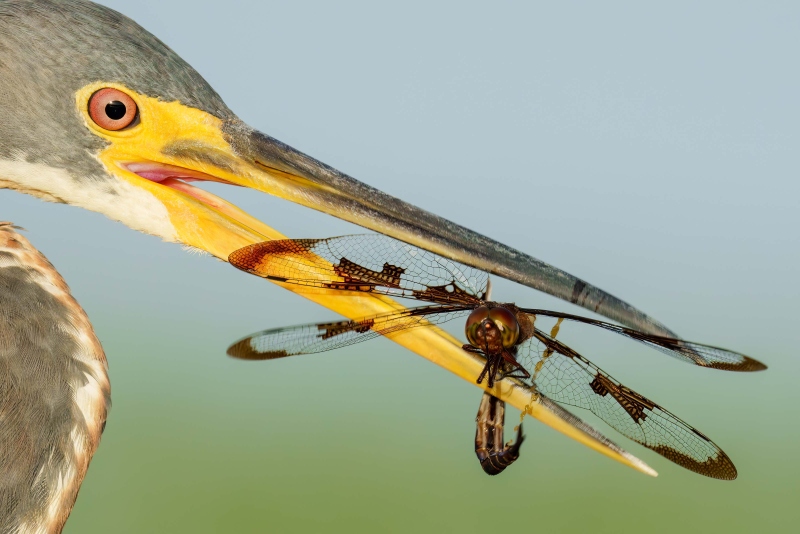
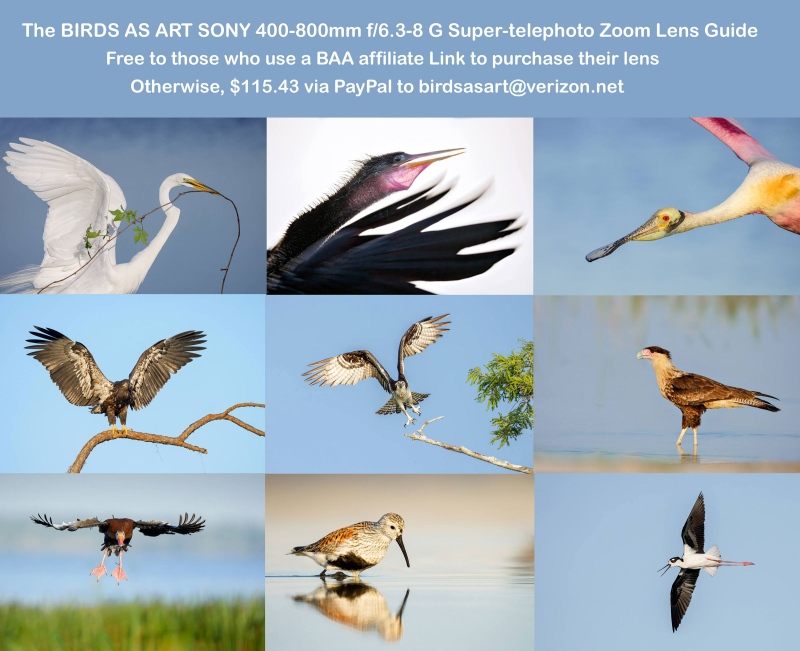






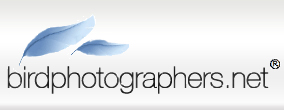


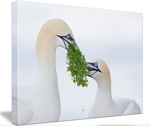
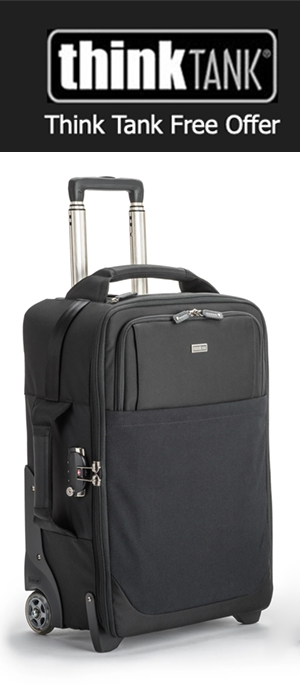


Another vote for Image 2. I suspect Artie would prefer having the entire head, bill, and dragonfly against blue sky, as in Image 1, and that would be the normal choice. But Image 2 is close enough in that regard, and the dynamism and more dramatic view of the dragonfly’s size (almost filling those 4-inch mandibles) puts it on top for me. And I agree with Tim Griffy about the water. In Image 2, the blue water leads the viewer’s eye up to the bill and dragonfly rather than left and right.
Thanks and an interesting discussion here 🙂
a, on the Auto Train headed for Lorton, VA
I’m an image 2 vote — the open beak gives the image a more dynamic look to me which I like. I also like the background in 2 better as well. It has a more pronounced bicolor look to my eye, probably because of the more pronounced blue streak in the lower half in the midst of the green shade. Both backgrounds are appealing, however. And thank goodness these photos were recoverable!
Hey Tim,
Thanks for chiming in. I will share my preferences tomorrow.
artie
Image 1 for me. I like the position of the bird and the way the neck moves my eye to the dragon fly in its bill. Both the bird and the position of the dragon fly creates a nice curve in the image. Thanks for sharing. Have a safe trip.
Thank you kindly, James. which background do you like best?
with love, artie
I like the one in the first image best due to the colors not competing with the subjects but give my eyes a place to rest.
You may be right; I may be crazy!
Billy Joel!
artie
Typo: “A young Great Egret preening”
I am so very glad you were able to restore the dragonfly images you “lost” while trying to help me with my new Sony a1! I like the background on #1 but my favorite is #2 because it’s such a great picture of the dragonfly (and it’s eggs!). How nice that Blair was able to identify the dragonfly for you.
Thanks, Pat. Different strokes!
with love, artie
ps: Typo fixed!
Although bird id is easier in #1, I like #2 for a better look at the dragonfly and the even more OOF background. But I’d be very happy with either photo.
Thanks, Elinor. Bird ID or dragonfly ID?
with love, artie
I prefer image 1 due to the positioning of the baskettail giving a good look at both subjects. While I like the open beak of image 2, the dragonfly isn’t as well positioned for me. The eggs, while interesting, don’t add enough to the image to make up for the positioning.
I also prefer the BG of image 1 over 2 and its orangish coloration in the LL corner.
Thanks and excellent!
with love, artie